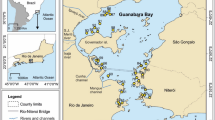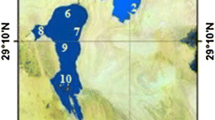Abstract
Organic matter (OM) plays an important role in the biochemical C cycle and in river waters, in particular. The paper considers a huge area of the Amur basin and its subbasins. The concentrations and distribution of OM in river waters were investigated during the summer of 2008 and 2010–2012. The conducted studies identified total, dissolved and particulate organic carbon (TOC, DOC and POC), humic substances (HS)–humic acids (HA) and fulvic acids (FA), and suspended matter (SM). It was established that concentrations of OM vary significantly along the river flow and hydrological cross sections due to inflows from major tributaries originated in various physio-geographical zones. The results showed that concentrations of TOC varied from two to several tens of mg C/L, but were dominantly high. In the Upper Amur basin water, concentrations of DOC were dominant; the amount of HS was 17–48 % of DOC. Upstream of the Songhua mouth, the amount of HS (up to 60 % of DOC) was mainly due to inflows from the Zeya and Bureya running over the taiga zone. High concentrations of OM and SM were detected in the water discharge from the Songhua, the amount of HS accounted for 20 % of DOC. In the Ussuri basin, formed in the coniferous broad-leaved forest zone, concentrations of OM were lower compared to the Amur water. In the summer of 2011 and 2012, fluxes of TOC over the Amur River to the Amur Liman were 9.168 × 103 and 11.029 × 103 t C/day, respectively.



Similar content being viewed by others
References
Academic Dictionaries and Encyclopedias. http://en.academic.ru/dic.nsf/mwc/81926/Songhua
Aeschbacher M, Graf C, Schwarzenbach RP, Sander M (2012) Antioxidant properties of humic substances. Environ Sci Technol 46:4916–4925
Al-Reasi HA, Wood CM, Smith DS (2011) Physicochemical and spectroscopic properties of natural organic matter (NOM) from various sources and implications for ameliorative effects on metal toxicity to aquatic biota. Aquatic Toxicol 103:179–190
An SQ, Tian ZQ, Cai Y et al (2013) Wetlands of Northeast Asia and High Asia: an overview. Aquat Sci 75(1):63–71
APHA (1989) American Public Health Association. Standard methods for the examination of water and wastewater. 17th Edition. DC APHA, Washington
Artem’ev VE (1993) Organic matter hydrochemistry in the river-sea system (Geokhimiya organicheskogo veshchestva v sisteme reka-more). Nauka, Moscow
Arzhanova VS, Yelpatyevsky PV (2005) Mountain geosystems: geochemistry, functioning and dynamics (Sikhote-Alin Mountains, Southern Russian Far East). Dalnauka, Vladivostok
Aschan O (1988) Soluble humus material of northern fresh water. J Prakt Chem 77:172–226
Bel’chikova NP (1975) Determination of humus in soil by IV Tyurin method. In: Sokolov AV (ed) Agrochemical methods of soil studies. Nauka, Moscow, pp 56–62 (in Russian)
Bs ISO 8245 (1999) Water quality—guidelines for the determination of total organic carbon (TOC) and dissolved organic carbon (DOC). British Standard Institution, London
Capelle S, Pellegrini S, Cotelle P, Imbenotte M, Pommery J, Catteau J-P (1996) Autoxidation of gentisic acid in aqueous media. Water Res 30:1299–1303
Carlberg GE, Martinsen K, Kringstad A et al (1986) Influence of aquatic humus on the bioavailability of chlorinated micropollutants in Atlantic salmon. Arch Environ Contam and Toxicol 15:543–548
Cook RL, Langford CH (1999) A Biogeopolymeric view of humic substances with application to paramagnetic metal effects on l3C NMR. In: Ghabbour EA, Davies G (eds) Understanding humic substances. Advanced methods, properties and applications. Royal Society of Chemistry. United Kingdom, Cambridge, pp 31–48
David MB, Vance GF (1991) Chemical character and origin of organic acids in streams and seepage lakes of central Maine. Biogeochemistry 12:17–41
Duchaufor P (1982) Pedology: pedogenesis and classification. George Allen and Unwin, London
Dudarev OV, Charkin AN, Semiletov IP, Krukhmalev AV (2010) Spatiotemporal variability of the organic carbon isotopic composition of suspended matter at the lower stream and estuary of the Amur River. Doklady Earth Scien 433:1132–1140
FAO-UNESCO (1974) Soil Map of the World 1:5000000. Vol 1. Legend. UNESCO, Paris
Fatoki OS, Vernon F (1990) Phthalate esters in rivers of the Greater Manchester area, UK. Sci Total Environ 95:227–232
Howard RW, Fucci JR, Sherman D (1991) Inputs of sediment and carbon to the estuarine ecosystems: influence of land. Ecol Appl 1:27–29
Huang N, Liu D, Wang Z, Zhang B, Song K, Li F, Ren C (2009) Distribution features of natural wetland in the Sanjiang Plain from 1954 to 2005. Wetland Sci 7(1):33–39 (in Chinese)
ISO 11923 (1997) Water quality —determination of suspended solids by filtration through glass-filter. International Organization for Standardization, Geneva
ISO 5667–6 (2005) Water quality sampling—part 6: guidance on sampling of rivers and streams. International Organization for Standardization, Geneva
ISO 7887 (1994) Water quality —examination and determination of colour. International Organization for Standardization, Geneva
Ivanov GI (1976) Soil formation in the southern part of the Far East. Nauka Publishing House, Moscow
Jackson TA (1975) Humic matter in natural waters and sediments. Soil Scince 19:56–64
Koprivnjak J-F, Pfromm PH, Ingall E, Vetter TA, Schmitt-Kopplin P, Hertkorn N, Frommberger M, Knicker H, Perdue EM (2009) Chemical and spectroscopic characterization of marine dissolved organic matter isolated using coupled reverse osmosis-electrodialysis. Geochim Cosmochim Acta 73:4215–4231
Krasyukov VN, Lapin IA (1988) USSR Inventor’s Certificate No. 1385041, Bulletin Inventions (Bulletin Izobreteniy) 12:175 (in Russian)
Levshina SI (2008) Dissolved and suspended organic matter in the Amur and Songhua waters. Water Resour 35:716–724
Levshina SI (2010) Organic matter in surface waters of the Middle and Lower Amur Basin. Dal’nauka Publishing House, Vladivostok
Levshina SI, Efimov NN, Bazarkin VN (2009) Assessment of the Amur River ecosystem pollution with benzene and its derivatives caused by an accident at the chemical plant in Jilin City, China. Bulletin of Environ Contam and Toxicol 83:776–779
Li Y, Xu L, Li S (2009) Water quality analysis of the Songhua River Basin using multivariate technique. Water Res Prot 1(2):110–121
Liu Ch, Wang Zh, Souza F (2009) Variations of runoff and sediment fluxes into the Pacific Ocean from the main rivers of China. In: Proceedings of the third international conference on estuaries and coasts (September 14–16, 2009. Senda, Japan) vol 1, pp 94–100
Ludwig W, Probst J-L, Kempe S (1996) Predicting the oceanic input of organic carbon by continental erosion. Global Biogeochem Cycles 10:23–41
Makhinov AN (2004) Long-term changes in the hydrological regime of the Amur River. In: Lutaenko KA, Shu Gao (compilers). Proceedings of the workshop climate variability and human activities in relation to Northeast Asian Land-Ocean interactions and their implications for coastal zone management, Nanjing, China, December 4–8, 2004. Nanjing University, Nanjing, pp 117–123
Makhinov AN, Kim VI (2013) Ice cover of the Amur River and its impact on channel processes. Water Resour 40(4):391–398
McDonald S, Bishop AG, Prenzler PD, Robards K (2004) Analytical chemistry of freshwater humic substances. Anal Chim Acta 527(2):105–124
Meybeck M (1982) Carbon, nitrogen and phosphorus transport by world rivers. Amer J Sci 282:401–450
Meybeck M, Ragu A (1996) River discharges to the oceans. An assessment of suspended solids, major ions and nutrients. Environment Information and assessment Rpt. UNEP, Nairobi
Miles CJ, Tuschall JR, Brezonik PL (1983) Isolation of aquatic humus with diethylaminoethylcellulose. Anal Chem 55:410–411
Mitchell GN (1990) Natural discoloration of freshwater: chemical composition and environmental genesis. Prog Phys Geogr 14:317–334
Moon S, Huh Y, Zaitsev A (2009) Hydrochemistry of the Amur River: weathering in a Northern Temperate basin. Aquat Geochem 15:497–527
Mordovin AM (1996) Annual and seasonal runoff of the Amur Basin rivers. Publishing House of the Institute of Water and Ecology Problems, Khabarovsk Research Center, Far Eastern Branch, Russian Academy of Sciences (IVEP KhNTs DVO RAN), Khabarovsk (in Russian)
Perdue EM (2009) Natural organic matter. In: Likens GE (ed) Encyclopedia of inland waters. Elsevier, Oxford, pp 806–819
Perminova IV, Grechishcheva NYu, Kovalevskii DV, Kudryavtsev AV, Petrosyan VS, Matorin DN (2001) Quantification and prediction of detoxifying properties of humic substances to polycyclic aromatic hydrocarbons related to chemical binding. Environ Sci Technol 35:3841–3848
Peuravuori J, Pihlaia K, Välimäki N (1997) Isolation and characterization of natural organic matter from lake water: two different adsorption chromatographic methods. Environ Int 23:453–464
Piccolo A (1994) Interaction between organic pollutants and humic substances in the environment. In: Senesi N, Miano TM (eds) Humic substances in the global environment and implications on human health. Elsevier, Amsterdam, pp 187–193
Reuter JH, Perdue EM (1977) Importance of heavy metal-organic interactions in natural waters. Geochim Cosmochim Acta 41:325–334
Ryan AC, Van Genderen EJ, Tomasso JR, Klaine SJ (2004) Influence of natural organic matter source on copper toxicity to larval fathead minnows (Pimephales promelas): implications for the biotic ligand model. Environ Sci Technol 23:1567–1574
Schlesinger WH (1997) Biogeochemistry: an analysis of Global Changes, 2nd edn. Academic Press, San Diego
Schnitzer M, Krendorff H (1981) Reactions of fulvic acid with metal ions. Water Air Soil Pollut 1:27–108
Sharapov NM, Kurganovich KA, Zaslonovskiy VN (2007) On the transboundary Argun River water quality monitoring. Water Sect Russ: Probl, Technol, Manag 6:36–47 (in Russian)
Smirnov MP (2009) Assessment of the Total and Anthropogenic Organic Matter Runoff from the Territory of the Commonwealth of Independent States. Water Resour 36(6):660–671
Smirnov MP, Tarasov MN, Mal’tseva AV et al (1988) River Runoff of organic matter from USSR territory and its variations over time (1936–1980). Gidrokhim Mater 103:67–83 (in Russian)
Soil Map of the Russian federation scale 1:2.500,000 (1988) In: Fridland VM (ed) Dokuchaev Institute of Soil of the Russian Academy of AGRICULTURAL Sciences. GUGK USSR, Moscow
Sun X, Zhou Q, Ren W, Li X, Ren L (2011) Spatial and temporal distribution of acetochlor in sediments and riparian soils of the Songhua River Basin in northeastern China. J Environ Sci 23:1684–1690 (in Chinese)
Thurman EM (1985) Organic geochemistry of natural waters. Martinus Nijhoff/Dr Junk W, Dordrecht
Vasil’kovskiy MG, Kupriyanov VV, Shubkina VV (1966) Bogs and their regime. In: Muranov AP (ed) Surface water resources of the USSR. Upper and Middle Amur, Gidrometeoizdat, pp 322–333 (in Russian)
Vernadsky VI (1924) Lageochemie. Alcan, Paris
Wang Z, Song K, Liu D, Zhang B, Zhang S, Li F et al (2009) Process of land conversion from marsh into cropland in the Sanjiang Plain during 1954–2005. Wetland Sci 7:208–217 (in Chinese)
Weber JH (1988) Binding and transport of metals by humic materials. In Frimmel FH, Christman RF (eds) Humic substances and their role in the environment. Chichester, Wiley, United Kingdom, pp 165–178
Acknowledgments
The author expresses her sincere gratitude to the collaborators from the Far Eastern Hydrometeorological Service Agency, Zabaikalie Interregional Territorial Agency of the Federal Service for Hydrometeorology and Environmental Monitoring and the researchers of the Institute of Water and Ecology Problems of the Far Eastern Branch of the Russian Academy of Sciences for their assistance in surface water sampling.
Author information
Authors and Affiliations
Corresponding author
Rights and permissions
About this article
Cite this article
Levshina, S. Geochemistry of organic matter in river waters of the Amur basin, Russia. Environ Earth Sci 75, 387 (2016). https://doi.org/10.1007/s12665-015-5202-0
Received:
Accepted:
Published:
DOI: https://doi.org/10.1007/s12665-015-5202-0




